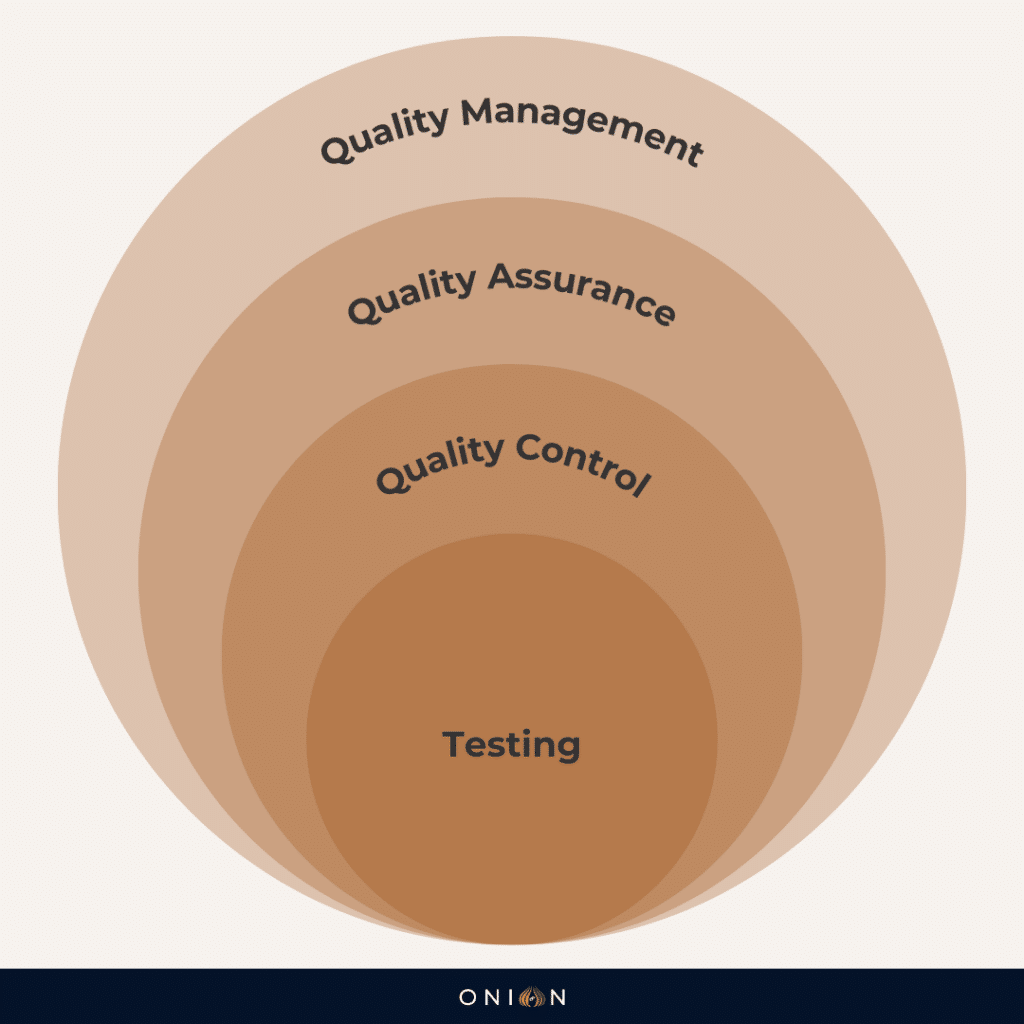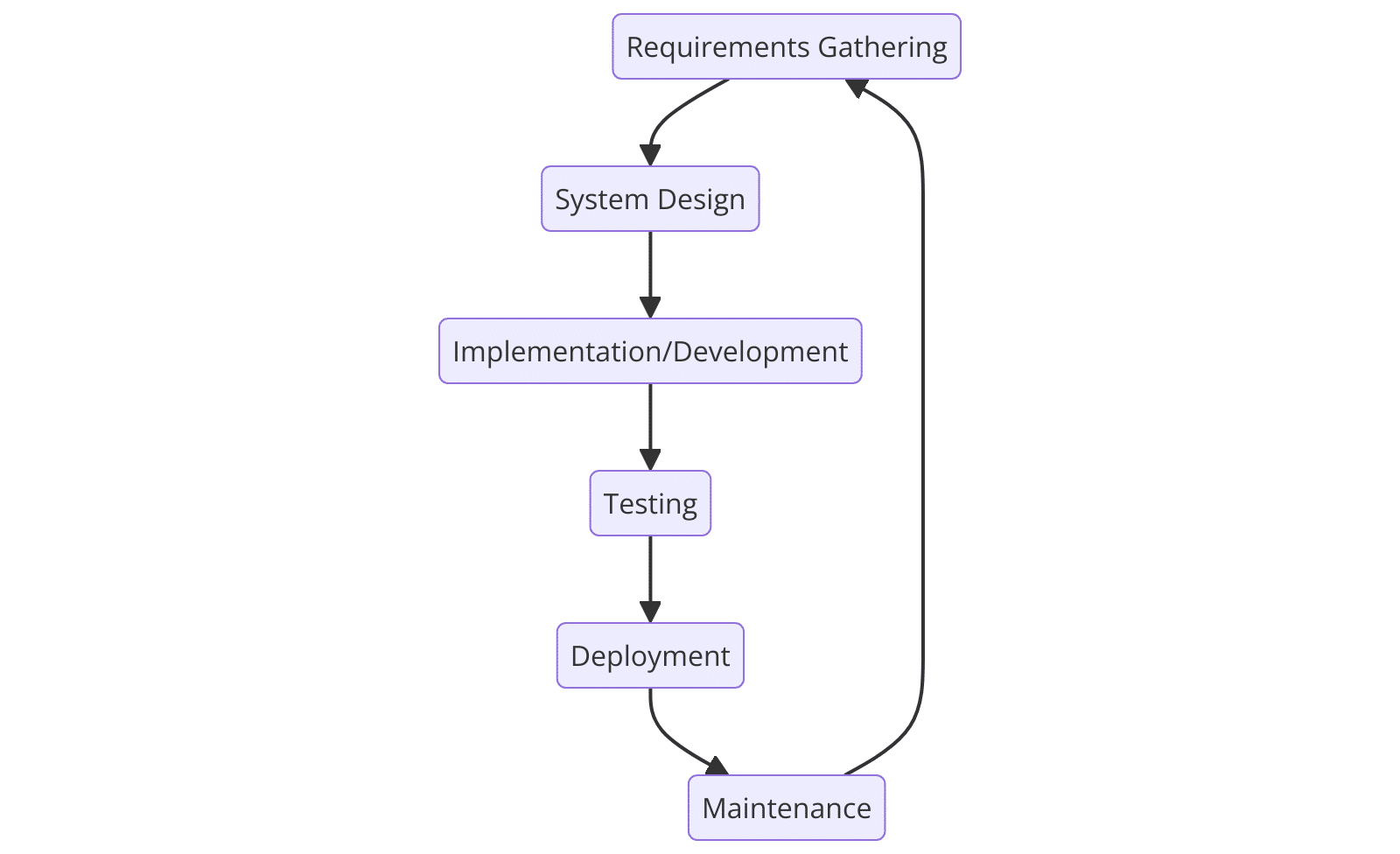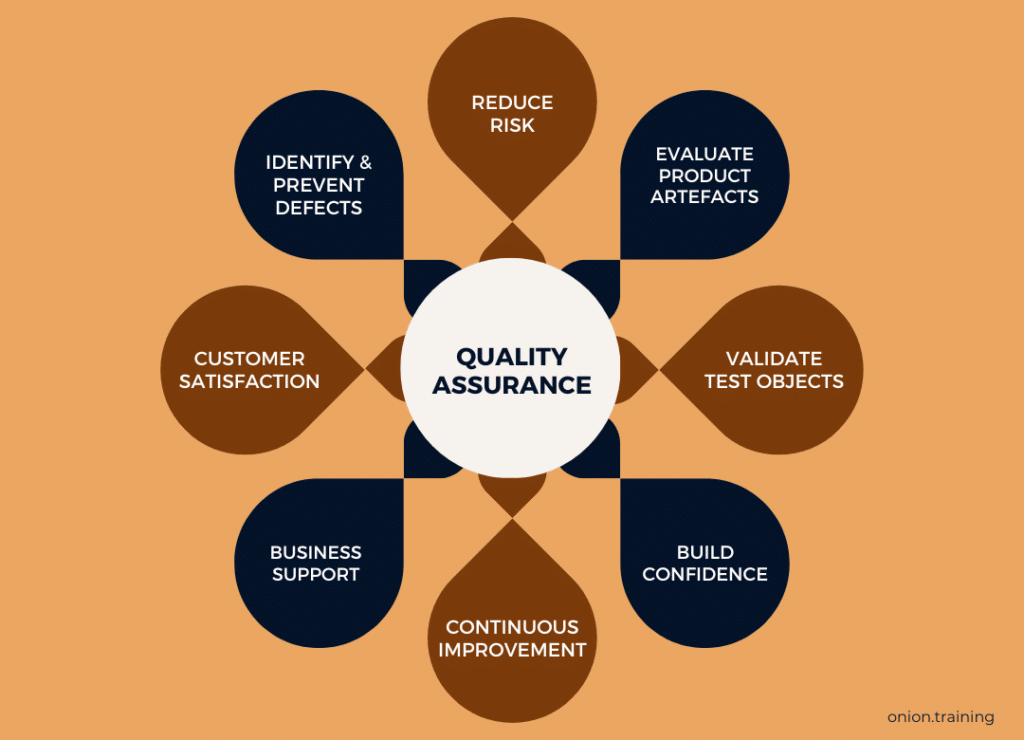Testing terminology in the software testing world can get rather confusing with words such as Quality Assurance, Quality Control and Testing used interchangeably. QA, QC and Testing are usually regarded as one of the same; but they are not.
The three entities are governed by the Quality Management system. Quality management encompasses a range of activities that guide and oversee an organisation’s approach to maintaining and enhancing its quality standards.

Here we explain the differences in these terms and how they apply to the world of software testing.
Quality Assurance (QA) places a strong focus on the organisational aspects of quality management. Its main objective is to ensure that the correct processes are followed, providing us with the assurance that we will attain the desired level of quality.
QA involves overseeing all the activities and tasks required to uphold a consistent level of excellence throughout the entire life cycle of a project. It goes beyond inspecting finished products; it involves supervising the entire development and testing process.
A crucial role of QA is instilling confidence that quality standards are being upheld. This confidence stems from knowing that the entire project team is following the right steps and procedures, as quality is a collective responsibility.
Quality Control (QC), meanwhile, is a process of verifying predefined requirements for quality. QC is applied to the finished product before the product is released. This involves validating the software against a set of requirements and verifying that the software meets those requirements. The QC process is used to check a software product does what we expect it to do and the QA process serves to give us confidence that the software product satisfies the needs of the end-user.
Testing acts as a bridge between QA and QC. Testing involves systematically evaluating the software to detect issues and failures. It’s like putting the software through various scenarios to see if it behaves as expected. Testing covers aspects like usability, performance, security and compatibility, which are all key to delivering a reliable product.
Imagine QC as the final checkpoint, QA as the overarching process ensuring quality at every step and Testing as the detective work that identifies and highlights any potential problems. Together, these components work hand in hand to achieve the desired levels of quality and deliver software that meets user expectations.
Now, in the world of software development, quality assurance (QA) stands as an unsung hero, striving to ensure that the products we rely on function seamlessly to meet the highest standards and user expectations. Not surprising when there are over 1.1 billion websites worldwide. It is a crucial part of the software development lifecycle (SDLC) and involves a variety of activities, such as reviewing, planning, designing and executing test cases and reporting defects to name a few.

Quality assurance isn’t just about ticking off a checklist; it’s a mindset. It’s about being proactive, foreseeing issues and ensuring that your software isn’t just functional but well-designed.
Software quality assurance involves the strategies and practices used to assess software development methods, processes, technologies and tools, ensuring the quality of the final product.
Quality assurance is an ongoing process that should be integrated into the SDLC from start to finish. It is important to have QA testers involved in all aspects of the development process, from requirements gathering to release management.
The goal of quality assurance is to ensure that the software meets the following criteria:
- Functionality: It should do what it’s supposed to do, meeting all identified functional requirements.
- Performance: The software should perform as expected, meeting defined performance requirements.
- Usability: It’s not just about working; it’s about being user-friendly and easy to understand.
- Reliability: Nobody likes software that crashes or malfunctions. Quality assurance ensures the software is reliable.
- Security: In this digital age, protecting sensitive data is paramount. Quality assurance confirms the software is secure and keeps unauthorised access at bay.

In this article, we dive deeper into the significance of quality assurance, its processes and how it leaves an impact on the ever-evolving world of technology.
Table Of Contents
What is Quality Assurance?
Quality Assurance places a strong emphasis on the organisational side of quality management. It’s all about making sure that the right processes are followed to give us that comforting certainty that we’re going to achieve the quality we’re aiming for.
Quality assurance involves managing all the activities and tasks necessary to maintain a consistent level of excellence throughout a project’s life cycle. It’s not just about checking finished products; it’s about overseeing the entire development and testing process.
One of the key roles of quality assurance is to establish a sense of confidence that quality standards are being met. This confidence arises from the knowledge that the right steps and procedures are being adhered to by the entire project team; after all, quality is everyone’s responsibility. Essentially, quality assurance acts as a safeguard to ensure that nothing falls through the cracks, which could potentially impact the final product.
QA collaborates with development and testing teams to enhance processes, leading to better products and more efficient releases. It ensures that the organisation is consistently meeting its quality goals and effectively guiding products from development to customer release.
The Significance of Quality Assurance: Why It Matters
Understanding the importance of quality assurance is like realising the value of a safety net for your digital endeavours. It goes beyond merely fixing bugs; it’s about preventing them from causing havoc in the first place. Imagine you’re not building a bridge of steel and concrete but a digital one – an intricate structure of code and functionality. The last thing you’d want is for it to crumble when users start navigating it.
In the world of software, quality assurance plays the role of a watchful guardian, ensuring that your creation is protected against potential digital disasters. It’s not just about patching up issues after they arise; it’s about implementing measures to stop them dead in their tracks. Think of it as building a bridge that’s not only sturdy but also thoroughly tested to withstand the digital footfall of users.
So, the significance of quality assurance lies in its proactive approach. It’s the assurance that your digital bridge won’t collapse unexpectedly, providing a smooth and secure journey for users as they navigate the digital landscape. Quality assurance is the safety checkpoint that ensures your software remains resilient, reliable and ready for whatever challenges come its way.
Quality Assurance Testing
Quality Assurance Testing is the method employed to validate and ensure the quality of a software product or service before it is released to customers. Unlike product creation, QA testing focuses on scrutinising the quality of the end product and the outcomes it can deliver.
It’s like having a reliable safety net for your application. Imagine you’re crafting this revolutionary app, something that could change the way people interact with technology. Now, enter the QA testers – they’re the trusty guardians making sure your app stands strong and runs smoothly, without any annoying glitches.
Their role is simple but crucial: they meticulously check every nook and cranny to ensure your creation is robust and free of bugs. It’s having a team of dedicated professionals who want to guarantee that your app performs at its best.
QA testing tasks include:
- Identifying and resolving errors and inconsistencies in documentation and software.
- Checking the user interface (UI) and user experience (UX) is seamless.
- Proving the business logic flow.
- Verifying the software meets the business/user requirements and expectations.
Why bother with all this scrutiny? Well, quality assurance ensures that your software meets all the necessary requirements and operates efficiently. It’s like having a behind-the-scenes superhero that ensures your app is a reliable companion for users, whether they’re attempting to conquer the digital world or just ordering a pizza. Successful QA testing uncovers errors and inconsistencies that could impact the practical use of the software. When executed accurately, QA testing guarantees the longevity of the product, ultimately saving both time and money. Explore all of this and more in our Software Testing course, tailor-made for those aspiring to be Quality Assurance Testers.
The Quality Assurance Process
Requirement Analysis and Planning: Setting the Foundation
The quality assurance journey begins with a thorough analysis of requirements, by aligning the project’s objectives and making sure everyone’s on the same page. What does the client want and how can we make it happen? This involves ensuring that all client expectations and project specifications are clearly understood and documented ensuring that every detail is crystal clear, preventing any confusion down the line.
QA test teams define the scope of their work and devise a testing strategy tailored to the project outlining the QA approach for each stage of the software life cycle, specifying the type of testing required and identifying the necessary tools. Test cases are also developed providing step-by-step instructions for each testing sequence, including checklists for both manual and automated testing methods.
These initial phases lay the groundwork for a successful project.
Design Review: Ensuring Adherence to the Blueprint and Maintaining Code Quality
Quality assurance doesn’t just kick in after the code is written. During the design phase, quality assurance examines the system architecture and design to identify potential issues and ensure that it meets the specified requirements. Issues can be caught early in the development process through code reviews and static analysis. Quality assurance thoroughly examines it for any failures, ensuring it adheres to the best practices so that it won’t result in future chaos.
Rigorous Testing: Unmasking Hidden Vulnerabilities
Time for testing! Testing is a fundamental component of quality assurance, covering various levels such as unit testing, integration testing and system testing. It includes capturing test results and reporting bugs, errors and other issues. This involves regression testing and analysis if previously identified bugs have been successfully resolved and checking for the development of new issues. The QA testers may create additional sub-tests to address these issues.
Deployment: A Smooth Transition to the Real World
Testing is completed – Woo-hoo! Test summary documents are prepared outlining all tests conducted during the software development life cycle, along with their results providing detailed insights into the number and nature of errors and anomalies detected. It registers the entire testing process and serves as a valuable resource for future software testing cycles. But even after the hard work is complete, quality assurance remains vigilant during the launch phase ensuring the software makes its debut without a hitch.
Continuous Improvement: The Quest for Excellence
Continuous improvement is the heartbeat of quality assurance – it’s not a one-off task but an everlasting quest for excellence.
Quality assurance within the Agile arena is adaptable; always evolving and getting better with each iteration. It’s not just about ticking boxes; it’s about a commitment to learning from every project, embracing feedback and making essential tweaks to elevate the quality of our software.
Unlike a single act, continuous improvement in quality assurance is a dynamic process that thrives on the wisdom gained from past projects where each step forward is a lesson learned and a chance to enhance. It’s about looking back, not to dwell on mistakes, but to learn from them. Every glitch, hiccup, or challenge becomes a stepping stone for refining and enhancing the quality of future software.
This ongoing pursuit of perfection involves a feedback loop that keeps the software on a trajectory of continuous enhancement, whether it’s user feedback, industry insights, or internal evaluations. Continuous Improvement means being adaptable and always ready to tweak and enhance based on the evolving landscape of technology and user expectations. It’s not just about fixing what’s broken; it’s about fine-tuning even the aspects that seem to be working well, ensuring that they work not just well but exceptionally well.
Quality assurance is a commitment to excellence that transforms each project into a step towards perfection. It’s the belief that there’s always room for improvement and the dedication to making those improvements happen, ensuring that software doesn’t just meet expectations but consistently exceeds them.
The Rise of Automation: A Powerful Ally
In the present-day world of modern technology, automation serves as a reliable partner for QA. Automated testing tools streamline the process, enabling us to identify and eliminate bugs with lightning speed.
This rise of automation isn’t just about speed; it’s about precision. Automated testing tools execute tasks with meticulous accuracy. They work tirelessly in the background, allowing QA professionals to focus on the strategic aspects of testing while the automation handles the repetitive, time-consuming tasks.
Together, quality assurance and automation are rewriting the rules of software testing, ensuring that bugs are swiftly identified and eliminated, leaving behind a digital landscape that’s robust and reliable.
Embracing Quality Assurance for a Brighter Future
So, what is quality assurance? It is not just a process; it is a guiding principle that illuminates the path to success in software development. It’s not just a box-ticking exercise; it’s about setting a standard that transcends the ordinary, shaping a future where software isn’t just functional but truly exceptional.
Sure, we’ve scratched the surface of ‘what is quality assurance,’ but in the vast tech jungle, there’s so much more to explore. Quality assurance is the key that unlocks the true potential of software, guiding us through the twists and turns of technological evolution. It’s not just a tool; it’s a mindset that propels us forward. Our Software Testing course covers all these aspects and more for those aspiring to become skilled Quality Assurance Testers.
As you embark on your tech journey, keep this in mind: quality assurance is not just a part of the process; it is the grounds for improvement. Keep testing, keep learning and keep pushing the boundaries of what’s possible.
Related Articles
6 Benefits of Well-Documented Software Requirements for Successful Projects
16 Undeniable Reasons Why AI in Software Testing Cannot and Will Not Replace Software Testers

